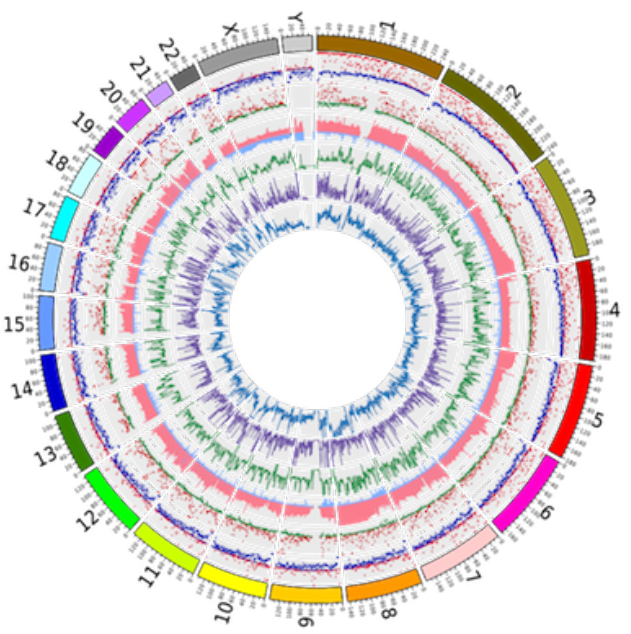
COSMIC Release v85
8 May 2018
The May COSMIC release (v85) is now live. There are 3 new fully curated genes, substantial curation updates for TERT, 1 new fusion pair, and 162 whole genome screened samples from 8 new systematic screen papers. We have also added 25 new hallmark genes to the Cancer Gene Census and added a new track to the main Genome Browser which displays mutation recurrence.
The newly curated genes include ERBB2, POLD1 and LRP1B.
ERBB2 - (erb-b2 receptor tyrosine kinase 3), which encodes HER3 (Human Epidermal growth factor Receptor 3), is a member of the epidermal growth factor receptor family, consisting of four closely related type 1 transmembrane receptors. ERBB3 is the final of the four genes to be expert curated by COSMIC. Unlike other members of the family, HER3 has impaired tyrosine kinase activity, but can function via ligand binding and heterodimerization with other members of the family to influence cell proliferation. Increased expression of HER3 has been observed in a number of cancers, where it has been linked with therapeutic resistance. Somatic mutations in ERBB3 are found across a wide range of cancer types, including colon and gastric cancer, with recurrent hotspots seen in the extracellular domain.
POLD1 - DNA polymerase delta 1 (POLD1) mutations from targeted screening studies have now been curated in COSMIC. Polymerase delta plays an essential role in the replication and repair of chromosomal DNA. Recent studies have shown that germline mutations in the proofreading domain of POLD1 predispose to cancer. They are present in 0.5-2% of patients in intestinal polyposis and CRC cohorts enriched for familial disease. Also low levels of somatic POLD1 mutations occur in multiple sporadic tumours, such as colorectal, gastric and endometrial carcinomas, melanomas and childhood brain tumours, where they often underlie an ultramutated phenotype and potentially a favourable prognosis. POLD1 is a large gene, and is likely to acquire somatic mutations secondary to other causes of increased mutation burden, such as MMR-deficiency; therefore it is important to differentiate pathogenic variants from passenger mutations that are of no functional consequence.
LRP1B - LRP1B (Low-density lipoprotein (LDL) receptor-related protein 1B) is a member of the LDL receptor family of lipoprotein receptors, which have many functions in the human body including cholesterol metabolism and atherosclerotic lesion formation. The gene encoding LRP1B is very large (1.9Mb, 91 exons) and situated on the long arm of chromosome 2 (2q21.2), in the FRA2F fragile site. The LRP1B gene was first discovered during the study of cancer cell lines harbouring homozygous deletions in this region; alterations of the gene in small cell lung cancer cell lines were suggestive of a tumour suppressor role. Further studies of the gene in different cancers have shown a high frequency of genetic changes including homozygous deletions (glioblastoma multiforme, and cancers of the oesophagus, nasopharynx, bladder and lung), point mutations (chronic lymphocytic leukaemia and cancers of the lung, nasopharynx, oesophagus, ovary and stomach) and promotor methylation resulting in transcription silencing. Later experiments, involving overexpression of a recombinant gene in lung cancer cell lines with little or no endogenous LRP1B expression resulted in significantly reduced cellular proliferation, confirming the postulated growth-suppressing function of the protein and role as a tumour suppressor.
We also have a significant update for TERT. More than 60 publications which include screening of TERT, sometimes alongside other genes, are included in this release. TERT encodes the reverse transcriptase component of telomerase which adds telomere repeats to chromosome ends enabling cell replication. Maintenance of telomere length is a key process in malignant progression. As well as the 2 common hot spot mutations in the TERT core promoter at positions c.1-124 (C228T) and c.1-146 (C250T) many other promoter variants have also been identified. TERT promoter mutations are frequent in melanoma and glioma, particularly glioblastoma. They are also found in numerous other solid tumours including hepatocellular carcinoma, urothelial bladder carcinoma and papillary thyroid carcinoma, as well as malignant phyllodes tumour of the breast and in higher grade meningioma.
There is also a new fusion pair, in the shape of RUNX1-RUNX1T1 (AML1-ETO) fusion. A proportion of the literature reporting on this fusion pair has been curated. The RUNX1-RUNX1T1 fusion results from the translocation t(8;21)(22q;22q), one of the most common cytogenetic abnormalities in acute myeloid leukaemia (AML). Along with inv(16) AML, these comprise the core binding leukaemias, both characterised by the disruption and transcriptional deregulation of genes encoding the subunits of the core binding factor, a transcription factor that functions as an essential regulator of normal haematopoiesis. RUNX1-RUNX1T1 is found in approximately 5-10% of all AML cases and is most common in AML with maturation (FAB M2). The fusion is consistent, with the amino terminal portion of RUNX1, including the runt homology domain, joined to almost the entire RUNX1T1 gene. The genomic breakpoints occur in RUNX1 intron 5 and RUNX1T1 intron 1. Evidence suggests the fusion alone is insufficient to induce leukaemogenesis but additional cooperating mutations are required, such as point mutations in KIT or NRAS. The prognosis is generally favourable for patients with RUNX1-RUNX1T1 AML; complete remission can be achieved with relatively long disease-free survival when patients are treated with high dose chemotherapy but additional activating mutations can confer a poorer prognosis.
We have also added 25 new hallmark genes to the Cancer Gene Census, all tier 1. They are ACVR1, AKT1 , AMER1, ARID1A, ARID2, ATF1, BAP1, BCOR, CALR, CASP8, CBL, CHEK2, CIITA, CRLF2, EZR, GNA11, GNAQ, GNAS, H3F3A, HNF1A, KDM6A, MED12, PAX3, PIK3CB and RECQL4.
There are 8 new systematic screens in version 85 COSP41629, COSP43278, COSP43218, COSP44684*, COSP44887, COSP43417, COSP44236 and COSP45027.
*Zehir A, et al. (Nat Med. 2017 Jun;23(6):703-713., PMID:28481359 ) describes the compiled tumor and matched normal sequence data from a unique cohort of more than 10,000 patients with advanced cancer. The MSK-IMPACT study from the Memorial Sloan Kettering Cancer Center New York, New York, USA is a clinical sequencing initiative and it has identified 78,240 clinically relevant somatic mutations from various tumour types.
A new 'Mutation Recurrence' track has been added to the main Genome Browser. This is a colour density track (pale yellow=low score, red=high score) across the whole reference sequence. Mouseover any nucleotide position on the track to see the score, which is the number of whole genome screened sample IDs with a coding or non-coding mutation at that position.
We want COSMIC to reach as many people as possible, and as part of our efforts to make the site easy to use for those who don't have English as a primary language we've added a new Google Translate widget. This can be found in the footer of any page and will do it's best to translate the site into any language offered by Google.
We have also improved our file download offering with new scripted download functionality to replace our SFTP server. You can read more about how to make use of this here.
For more details on the release, check the release notes.
